
Member Profile: Mary Whitton
1. What do you do and how long have you been doing it?
I retired from 25 years (1995-2020) in the computer science department at UNC-Chapel Hill as a Research Professor. At UNC my first title was manager of the graphics laboratory where I worked closely with Henry Fuchs and Fred Brooks. Fred and I formed the Effective Virtual Environments (EVE) research group in 1998. We graduated our last PhD graduated in 2016 and I worked part-time until 2020. I still have one or two active collaborations and I do volunteer work on computer graphics history.
2. What was your first job?
Hmmm, which career? I taught junior high math for three years before going back to school in electrical engineering in 1976 to learn computer graphics. My first job in graphics was co- founder and VP for sales and marketing of Ikonas Graphics Systems (1978) where, in traditional startup fashion, I did lots of things including circuit design, managing trade shows, and writing and laying out marketing materials. Graphic design was harder back then than now since Adobe layout products and the Apple MAC came out several years later.
3. Where did you complete your formal education?
I have a BA from Duke (1970), an MS in Guidance and Personnel Services from NC State (1974), and an MS in Computer Engineering from NC State (1984). My two startup co-founders and I claim that we got MBAs at the School of Hard Knocks.
4. How did you first get involved with SIGGRAPH?
My first SIGGRAPH was 1977 and Ikonas first exhibited in 1979. At the conference, we hung out with Ikonas customers who were active in the SIGGRAPH organization. Through these folks I connected with the Professional Chapters leadership and I started the Research Triangle Local SIGGRAPH chapter in about 1982.
5. Describe a project you’d like to share with the SIGGRAPH community.
I’ve been interested in and working on capturing ACM SIGGRAPH and computer graphics history since the mid-2000s. My focus is recording, preserving, and making accessible the “stories and stuff” of computer graphics. The ACM SIGGRAPH History Committee team created the big SWAG and graphics hardware history exhibits at the 50 th conference in 2023. We also did two publications to celebrate the 50 th conference: a special issue of IEEE Computer Graphics and Applications with a 70-page collection of stories submitted by SIGGRAPH attendees titled “The Big 50: Celebrating 50 SIGGRAPH Conferences” and volume 2 of Seminal Graphics Papers: Pushing the Boundaries.
6. If you could have dinner with one living or non-living person, who would it be and why?
I’d love to have one more dinner with my Trancept Systems startup co-founders–Nick England, Tim Van Hook, and Robert Whitton (d. 2011). Wicked sharp minds, wicked humor, and abiding mutual respect. And if I could invite Ivan Sutherland to join us to talk about fostering innovation, it would be even more memorable. Why not Fred Brooks? Well, I worked with Dr. Brooks for 25 years and we talked almost weekly over lunch at Bandido’s Mexican Cafe.
7. What is your favorite memory of a SIGGRAPH conference?
In 1979 Ikonas was the only company on the trade show floor displaying a full-color version of “The Compleat Angler” image from Turner Whitted’s seminal paper introducing ray-tracing (doi> 10.1145/800249.807419). The red, green, and blue color data were loaded into the Ikonas frame buffer from three separate 265K byte 8″ floppy disks. Being able to display this image turned out to be a great marketing tool as everybody who was anybody came by to see the image and we collected contact info from them all for our sales lead database.
8. What is something most people don’t know about you?
In my 40s I started driving sports cars at driver training and car club events on road-course racing circuits such as Road Atlanta, Watkins Glen, and Virginia International Raceway. That led eventually to my buying and racing a 1967 Fiat 850 race car several times a year in vintage race club events.
9. From which single individual have you learned the most in your life? What did they teach you?
My parents, Beau and Daphne Whitton, from whom I learned to be curious, to be kind, and to be responsible. My husband, Nick England, who changed the trajectory of my life when he introduced me to computer graphics in 1976.
10. Is there someone in particular who has influenced your decision to work with ACM SIGGRAPH?
In 1989 Kelly Booth, then SIGGRAPH President, asked me to run for the SIGGRAPH Executive Committee. I would never have thought of being involved at that level if he hadn’t asked.
11. What can you point to in your career as your proudest moment?
Entrepreneurial: Delivering products that enabled Ikonas and Trancept customers to do ground- breaking work in areas such as 3D volume rendering for medicine and oil exploration, advanced rendering, and image processing. Many of those customers are still friends. Academic: Receiving the IEEE VR Career Award (2021).